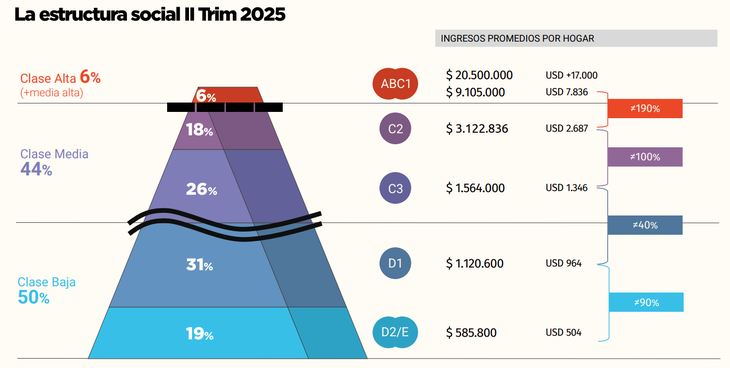After months of growth of the Argentine economynew alert signs begin to be seen: the recovery initiated at the beginning of the year fails to consolidate in a homogeneous way and the disparities between social sectors are deepened, according to the latest report of the consultant Moiguer. Growth slows down While consumption stagnates And its behavior is disappearing between a part of the population that accesses imported goods and trips, and another that continues to restrict essential expenses.
“Economic recovery does not reach everyone and deepens the inequalities of the present among the different social strata“synthesizes the study, which shows how the medium and low segments are forced to reduce basic consumption, while high and high average levels expand their dollar expenses.
The data behind the adjustment in middle and low sectors: unemployment and salary in backward
The setback of the consumption of the middle and low sectors is given in parallel with a fall in employment in the first quarter of the year: unemployment climbed to 7.9%, according to the last data of INDEC. This is the highest level since Javier Milei assumed the presidency and reached maximum from the exit of the pandemic, with a unemployment that especially hits the youngest and women.
In turn, Labor income continues without winning inflation: registered salaries (private and public) accumulate a 6% loss in real terms between November 2023 and March 2025. Within the category of the registered, the public salary It continues to be the most beaten, since it fell 15.1% real in that period, while the private ones yielded 0.9%, which is explained in its entirety for the March decrease.
The report also reflects this deterioration in the perception of the population: 61% of households said that in the second quarter of the year their income was below inflationwhile only 11% say they were above and 28% who paid it. In addition, a 50% Of the total population declares not to reach the end of the month and 30% say that basic expenses to pay for services must resignalthough in both cases in the low segments that percentage reaches 64% and 45%, respectively.
consumption.png
Consumption bifurca: it expands in dollars, but it is adjusted in pesos
Despite the brake on mass consumptionthe items linked to dollar They show an accelerated expansion: the Sale of 0km grew 94%, while broadcasting advanced 80% and imports of consumer goods climbed 60%. In contrast, the Sales of supermarkets and food fell between 4% and 9%respectively, according to data from Scentia and Came.
In this way, it is observed that while a part of society makes purchases abroad and plans trips, another depends on promotions and discounts to support their standard of living. The report shows “expansive profile” in consumption for middle levels, but a continuous adjustment pattern in the rest of the pyramid.
social pyramid.png

Although the inflation its deceleration continues -with a rise of just 2.4% in April and 1.5% in May, according to Indec-,, Social perception does not accompany that improvement. He 26% of respondents defines the situation of the country with words such as “Recession”, “instability” or “crisis”and a 36% He believes that There is a high probability of a new economic crisis in the coming months. The improvement in the indices, far from relieving the climate, seems to aggravate the feeling of inequality.
While the economy grows, so does inequality. This segmented growth deepens the exclusion of the low sectors, erodes social cohesion and credibility on economic direction.
So and everything, the 43% has a positive expectation and Associates the current situation with words such as “Bonanza”, “Esperanza”, “Stability” and “Growth”.
With one low inflation and some recovery signalsthe government insists on showing the “green outbreaks” of its management, but the report of Moiguer It suggests that, behind averages, reality is much more unequal. While the high sectors dollarize and expand their consumption, most continue to adjust.
Source: Ambito




